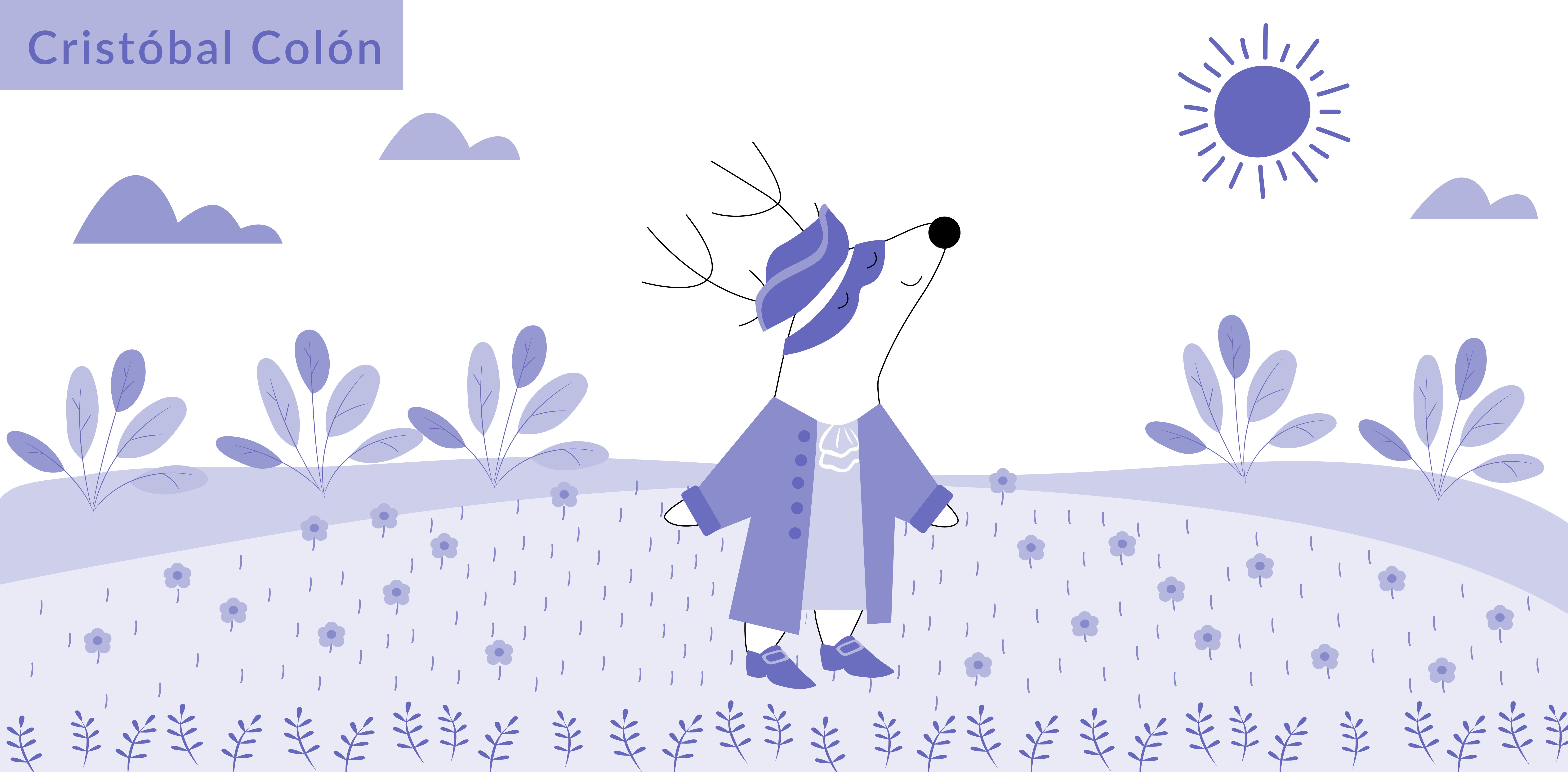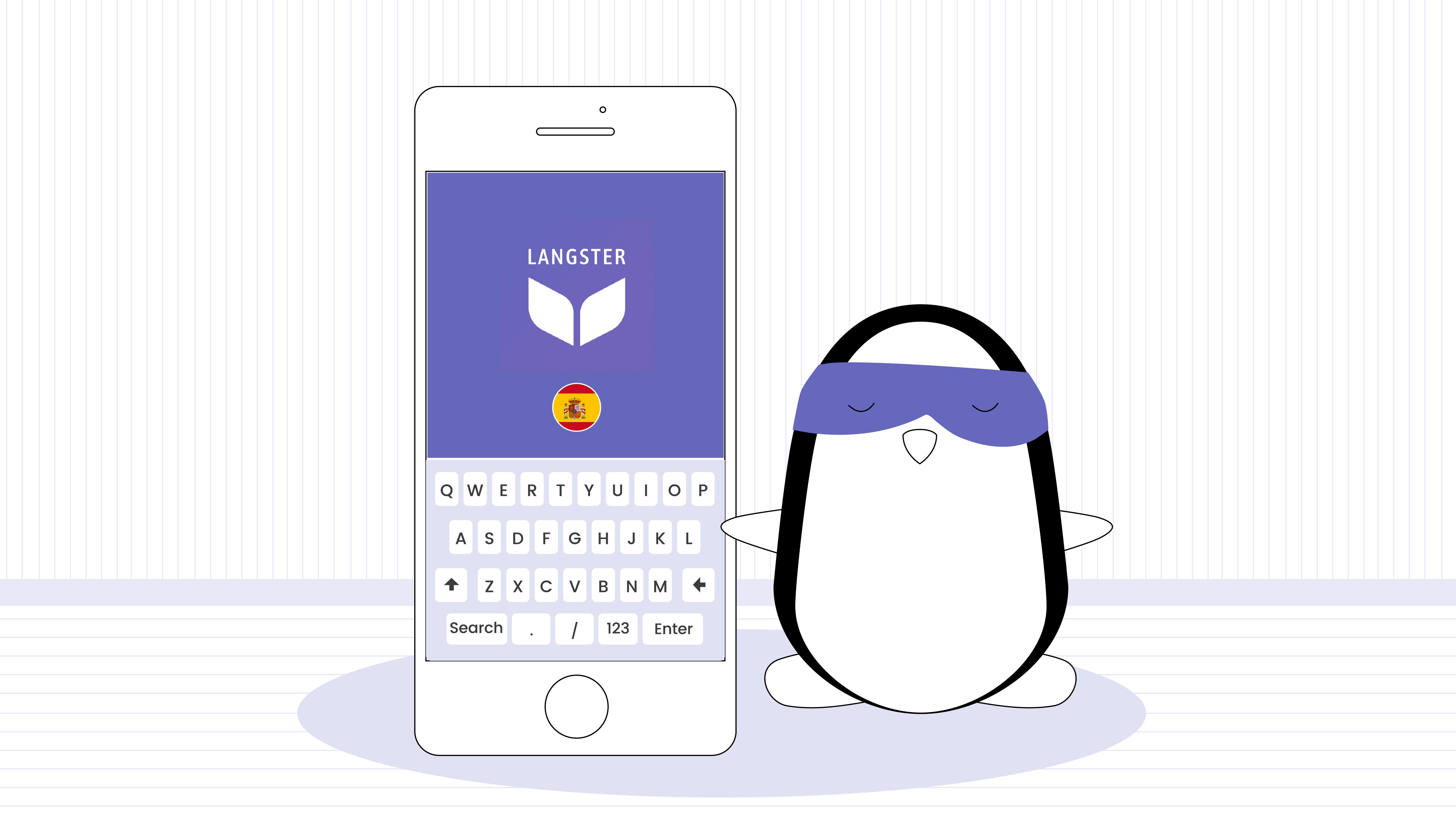
Catalan and Spanish, two of the most vibrant and historically rich languages of the Iberian Peninsula, share both similarities and differences that reflect the diverse tapestry of the region's cultural and linguistic landscape. This article aims to explore the nuances of both languages, tracing their origins, evolution, and the ways in which they have shaped and been shaped by the cultures of those who speak them.
By examining linguistic features, dialects, and cultural expressions, we'll uncover the unique characteristics that make Catalan and Spanish distinct yet intimately linked within the broader context of the Spanish-speaking world.
Learn Spanish with Langster
A Brief History of Spanish
Spanish is a Romance language that evolved from Latin dialects on the Iberian Peninsula after the fall of the Roman Empire.
It spread throughout Spain with the Reconquista and eventually made its way to the New World and other regions through Spanish colonization, becoming one of the most widely spoken languages in the world. Spanish vocabulary has even spread to other languages like English, too.
Evolution and Global Expansion
The global expansion of Spanish began with Christopher Columbus's voyages in 1492, marking the beginning of a period of exploration and colonization that brought the language to America, the Philippines, Africa, and other parts of the world.
This expansion facilitated the development of different regional varieties of Spanish, enriching the language with new accents, vocabulary, and expressions specific to each region.
Spanish Dialect
Today, over 500 million people in Castilian Spain speak Spanish as a native language, making it the second most spoken language in the world by number of native speakers.
It is officially spoken in 21 countries spread across the Americas, Europe, and Africa, including Spain, Mexico, most countries in Central and South America, and Equatorial Guinea. Each region contributes to the linguistic and cultural richness of Spanish with its own dialects and variations.
Spanish in the Contemporary World
In the contemporary world, Spanish not only plays a crucial role in global communication but also in economics, diplomacy, and culture. Additionally, it is an official language of international organizations such as the United Nations and the European Union.
Its importance in the United States has also grown significantly, with a large population of Spanish speakers making it the second most spoken language in the country.
The Importance of Language in Culture
Spanish is a powerful vehicle through which the rich traditions, history, and cultural expressions of the people who speak it are expressed. From literature to music, film, and the arts, the cultural and creative impact of Spanish-speaking countries is profound and wide-ranging.
Learning Spanish is not just learning another language; it’s immersing oneself in a world of opportunities to explore and understand human diversity.
A Brief History of Catalan

Catalan, also a Romance language, originated in the Middle Ages in the region now comprising Catalonia, parts of Valencia, the Balearic Islands, Andorra, and some areas of France and Italy.
Although it has faced periods of repression, today, it is a co-official language in Catalonia, boasting a thriving literary culture and a strong sense of regional identity.
Periods of Repression and Recovery
During the 18th century, especially after the War of the Spanish Succession, Catalan faced severe periods of repression, with its public use severely limited. Centralizing policies imposed by successive governments sought linguistic uniformity in favor of Spanish.
However, by the late 19th and early 20th centuries, Catalan Spanish experienced a cultural revival known as "La Renaixença," where the Catalan language, culture, and identity were reclaimed.
Legal Recognition and Present Day
With the restoration of democracy in Spain in 1978, Catalan regained its legal status as a co-official language in Catalonia, the Balearic Islands, and the Valencian Community through their respective autonomy statutes.
Today, Catalan is present in education, public administration, and the media. Furthermore, the language and culture are strongly promoted, both regionally and internationally.
Where It Is Spoken
Catalan is primarily spoken in four autonomous communities in Spain: Catalonia, the Balearic Islands, the Valencian Community (where it is called Valencian), and a small area of Aragon.
It is also the official language of Andorra, in addition to having a presence in the city of Alghero on the island of Sardinia, Italy, and in the Department of Pyrénées-Orientales in France. This geographical distribution reflects the diversity and cultural richness of Catalan-speaking territories.
Number of Speakers
It is estimated that there are approximately 10 million people who can speak Catalan, of which around 4 million are native speakers. Although this figure may vary depending on the source, Catalan is undoubtedly among the top 100 most spoken languages in the world.
Its teaching and use on social media and the internet have grown significantly, contributing to its dissemination and increasing its prestige both in Spain and internationally.
How Much Does Catalan Differ from Spanish? Common Distinctions
Although Catalan shares Latin roots with Spanish and other Romance languages, it has unique characteristics. Its spelling and phonetics are distinct, and the grammatical structure presents its own complexities.
For example, using personal and possessive pronouns in Catalan can differ greatly from Spanish.
Differences in Pronunciation
One of the first notable differences between Catalan and Spanish is pronunciation. For instance, Catalan distinguishes between open and closed vowels, as seen in Portuguese and French, a feature that does not exist in Spanish.
Also, Catalan features the neutral vowel, called "e" schwa (ə), which has no equivalent in Spanish. Another example is the pronunciation of "ll," which in Spanish sounds like /ʝ/ (yeísmo), while in Catalan, it is pronounced as /ʎ/ (a lateral palatal approximant).
Lexical Varieties
Lexically, Catalan and Spanish share many words due to their common Latin origin, but there are also numerous differences. For example, the words ventana in Spanish and finestra in Catalan, or llave and clau, illustrate how each language has evolved uniquely from Latin.
Additionally, Catalan has incorporated linguistic borrowings from other languages, especially French and Occitan, which have increased the lexical differences between the two languages.
| Spanish example | Catalan example | English translation |
|---|---|---|
| La ventana de la casa está abierta. | La finestra de la casa està oberta. | The window of the house is open. |
| La llave está en la mesa. | La clau és a la taula. | The key is on the table. |
| Spanish example | Catalan example | English translation |
|---|---|---|
| La ventana de la casa está abierta. | La finestra de la casa està oberta. | The window of the house is open. |
| La llave está en la mesa. | La clau és a la taula. | The key is on the table. |
Grammatical Differences
One of the most noticeable differences in grammatical terms is the formation of verb tenses. For instance, Catalan uses a periphrastic structure for the future tense (anar + infinitive, equivalent to ir a in Spanish) as the main form in colloquial speech, something that is not as predominant in Spanish.
Moreover, Catalan has a more complex clitic pronominal system than Spanish, including forms like "li" (le) and "els" (les), which indicate gender and number in a more specific way.
Distinctions in Article Usage
Like Spanish, Catalan uses definite articles el, la, els, les, but it also includes contracted forms when these precede prepositions, such as del (de + el) and al (a + el).
Additionally, Catalan has a definite article l' used before words starting with a vowel, regardless of their gender or number, something that does not have a direct equivalent in Spanish.
| Spanish example | Catalan example | English translation |
|---|---|---|
| El libro está en la mesa. | El llibre és a la taula. | The book is on the table. |
| Voy al supermercado. | Vaig al supermercat. | I'm going to the supermarket. |
| Spanish example | Catalan example | English translation |
|---|---|---|
| El libro está en la mesa. | El llibre és a la taula. | The book is on the table. |
| Voy al supermercado. | Vaig al supermercat. | I'm going to the supermarket. |
Formal and Informal Address
The use of address forms varies significantly between both languages. In Catalan, the use of tu (you) and vosaltres (you plural) for informal address and vostè (you) and vostès (you plural) for formal address parallels with peninsular Spanish.
However, Catalan tends to use formal forms more frequently in contexts requiring certain politeness or formality, whereas in Spanish, especially in Latin America, usage can vary considerably depending on the region.
Influences from Other Languages
Lastly, due to its geography, Catalan has historically been influenced by other languages with which it has coexisted, including Occitan and Aragonese in the Middle Ages and, more recently, French and Italian.
These influences have enriched Catalan lexicon and phonetics with elements not found in Spanish, providing Catalan with a unique linguistic identity within the Romance language family.
Similarities Between Catalan and Spanish

Even though they are different languages, Spanish and Catalan share many features. Let's have a look!
Shared Latin Origins
Both Catalan and Spanish evolved from Vulgar Latin, which the Romans brought to the Iberian Peninsula over 2,000 years ago. This common ancestry is evident in the many cognates and near-cognates shared between the two languages.
For example, Spanish uses escuela for “school” and puerta for “door,” while Catalan says escola and porta. These similarities underline the deep-rooted linguistic ties fostered by a shared history.
Similar Syntactic Structures
The syntactic structures of Catalan and Spanish are broadly similar, reflecting their Romance language heritage. Both languages typically follow a Subject-Verb-Object (SVO) order in simple sentences. This parallel structure facilitates comprehension across the languages, making it easier for speakers of one language to learn the other.
Both languages also employ gender and number agreement between nouns, adjectives, and verbs — a characteristic feature of Romance languages.
Use of Romance Verb Conjugations
Catalan and Spanish inherited similar verb conjugation patterns from Latin, which is a hallmark of Romance languages. While there are distinctions in the specific forms and some irregularities, the overall method of conjugating verbs in the present, past, future, conditional, and subjunctive moods is recognizable between both languages.
For instance, the infinitive forms of regular verbs in both languages often end in -ar, -er, or -ir, such as:
- cantar (to sing in both Spanish and Catalan),
- comer (to eat in Spanish) and menjar (to eat in Catalan),
- vivir (to live in Spanish) and viure (to live in Catalan).
Vocabulary Overlap
Despite their lexical differences, Catalan and Spanish share a significant amount of vocabulary, making it easier for speakers of one language to recognize words and phrases in the other. This overlap is not only due to their common Latin roots but also because of centuries of coexistence and cultural exchange.
Words related to everyday life, nature, and society often resemble each other, such as amor (love), mar (sea), and festa (party), which have the same or very similar spellings and meanings in both languages.
Pronominal Differences Between Catalan and Spanish
When it comes to pronouns, both Catalan and Spanish share several similarities, largely due to their common Latin heritage. However, there are notable differences in the use and form of pronouns that highlight the distinct evolution of each language.
For instance, Catalan possesses a more nuanced system of object pronouns, including the distinct indirect object pronouns li and els, which are used for singular and plural masculine or mixed-gender objects, respectively. This is in contrast to Spanish, which uses le for singular and les for plural indirect objects without distinction for gender.
Additionally, Catalan utilizes enclitic and proclitic pronouns in a manner that can differ significantly from Spanish. For example, in certain verb constructs, Catalan might place the pronoun after the verb, forming a single word, whereas in Spanish, the pronoun typically precedes the verb.
This reflects the flexibility and complexity of the pronominal system in Catalan, which can be a challenge for Spanish speakers learning the language despite the overarching similarities between the two languages.
Does Catalán have 2 genders?

Yes, like many Romance languages, Catalan incorporates gender into its grammatical structure. Nouns and adjectives are categorized as either masculine or feminine, which influences their definite and indefinite articles, as well as their adjectives and some verb forms.
This gender agreement extends to plural forms as well, with distinct endings for masculine and feminine plural nouns and adjectives. The language's use of gender is an integral aspect of its syntax and semantics, contributing to its complexity and richness.
| Catalan example | Gender | English translation |
|---|---|---|
| El gat | Masculine | The cat |
| El cotxe | Masculine | The car |
| El llibre | Masculine | The book |
| La taula | Feminine | The table |
| La casa | Feminine | The house |
| La flor | Feminine | The flower |
| Catalan example | Gender | English translation |
|---|---|---|
| El gat | Masculine | The cat |
| El cotxe | Masculine | The car |
| El llibre | Masculine | The book |
| La taula | Feminine | The table |
| La casa | Feminine | The house |
| La flor | Feminine | The flower |
Political Influences When Speaking Catalán
The choice between using Catalan words and Spanish in the Catalonia region is not solely a matter of personal preference or linguistic comfort—it also carries deep political implications.
The historical suppression of Catalan, particularly during the Franco dictatorship in Spain, when public and private use of the language was prohibited, has made it a symbol of regional identity and resistance.
In the contemporary context, the decision to speak Catalan versus Spanish can reflect one's political stance on issues such as Catalan independence, regional autonomy, and cultural preservation.
Consequently, language choice in Catalonia is often intertwined with political identity, with the use of Catalan being seen as an assertion of independence and a distinct cultural identity from the rest of Spain.
Language and Political Movements
Catalan has played a central role in Catalonia's political movements, particularly in the fight for independence from Spain. Political rallies, official regional government communications, and public education in Catalonia often prioritize Catalan to reinforce local identity and political aspirations.
This has implications for the social and political inclusion of non-Catalan speakers and emphasizes the role of language as a tool for political mobilization and expression. The promotion of Catalan is thus not only about preserving a linguistic heritage but also about asserting a political statement regarding the autonomy and distinct identity of Catalonia.
The Impact of Language Policies
The differing language policies between the Spanish government and the Catalan regional government further highlight the political influences on language use. The Catalan government promotes policies that favor the use of Catalan in education, public administration, and media, aiming to reinforce and normalize its use in all aspects of public life.
On the other hand, the Spanish government seeks to ensure the prominence of Spanish nationwide, including in Catalonia, often leading to tensions over language rights and educational curricula. These policies reflect broader political debates over national identity, regional autonomy, and the rights of linguistic communities within Spain.
Language as a Symbol of Resistance and Unity
In sum, the use of Catalan goes beyond simple communication; it acts as a powerful symbol of resistance against centralized control and cultural homogenization. It represents a form of unity for many Catalans, embodying their historical struggles, cultural pride, and political aspirations.
However, this symbolic significance also poses challenges, potentially polarizing Catalan society and complicating the region's relationship with the rest of Spain. The political implications of language use in Catalonia thus underscore the complex role that languages can play in regional and national identities, demonstrating how linguistic practices are deeply interwoven with political contexts and struggles.
Reasons to Learn Catalan
Learning Catalan offers many benefits that extend beyond the mere ability to communicate in another language.
Proficiency in Catalan opens up unique opportunities to immerse oneself fully in Catalonia's rich cultural heritage, allowing for a deeper understanding and appreciation of its history, literature, art, and traditions.
Additionally, given the political nuances surrounding the use of Catalan, learning the language can serve as a gesture of respect and solidarity with the Catalan people and their quest for identity and autonomy.
For professionals and scholars, Catalan proficiency can unlock access to regional job markets and academic resources otherwise inaccessible to non-speakers. Furthermore, learning Catalan enriches one's linguistic skills, providing insights into the Romance language family's dynamics and enhancing overall cognitive abilities.
In essence, learning Catalan is not just an acquisition of linguistic skills but an entry into the heart and soul of Catalonia, making it a rewarding endeavor for anyone with personal, professional, or academic ties to the region.
The Bottom Line

In conclusion, the intricate interplay between language and identity in Catalonia underscores the profound impact of Catalan on regional culture, politics, and social dynamics. As we've explored, understanding Catalan is not just about mastering another language; it's about gaining insight into a deeply rooted cultural and political narrative that spans centuries.
For those looking to connect with Catalonia on a more meaningful level, learning Catalan is an invaluable step. However, for individuals new to the linguistic landscape of Spain and interested in a broader entry point, learning Spanish can serve as a foundational stepping stone.
To this end, you can use Langster as an innovative and interactive platform for speaking Spanish like a native. With its engaging content and focus on real-life language use, Langster can help you build a solid foundation in Spanish words while preparing you for the unique linguistic nuances of regions like Catalonia.
Learn Spanish with Langster, and then why not start your Catalan language journey?
Learn Spanish with Langster









